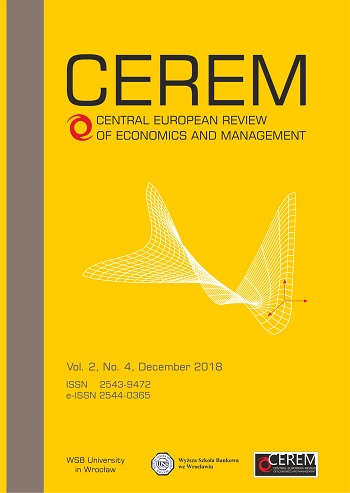Measuring energy efficiency - structural and index decomposition analysis
DOI:
https://doi.org/10.29015/cerem.584Słowa kluczowe:
energy efficiency, index decomposition analysis, structural decomposition analysis, indicators, energyAbstrakt
Aim: The aim is to recognize the main determinants of the energy efficiency improvement in transport in Poland in the years 2000-2014 using structural and index decomposition analysis, and to identify areas where there is still potential for further reduction of energy consumption.
Design / Research methods: Techniques used to analyse changes in energy use are: structural decomposition analysis and index decomposition analysis. Each of these two methods is characterized by distinctive, unique techniques and approaches, as they have developed quite independently. Index decomposition analysis measures the impact of energy efficiency gains on the level of energy consumption, at the most detailed sector disaggregation level allowed by the available data. Whereas structural decomposition analysis allows to analyse the impact of the external factors, such as technological, demand, and demographic effects, on the fluctuations of the total energy consumption. The similarities and differences between the two approaches are summarized and illustrated with a numerical example of Polish transport.
Conclusions / findings: The article recognizes the main determinants of the energy efficiency improvement in transport sector in Poland in the years 2000-2014. In case of Poland ODEX shows an overall progress of energy efficiency in transport by 24.3%. Results obtained with decomposition analysis indicate large divergences in energy efficiency improvements between modes of transport and vehicle types and identify areas where there is still potential for further reduction of energy consumption. Results from decomposing structure of energy use, show activity effect to be main reason for energy use growth. The distribution of each mode in total traffic of passengers and goods changes toward less energy efficient modes. The only factor driving down the energy use is energy savings.
Originality / value of the article: Using two methods of decomposition analysis and comparing obtained outcomes allows to get a broader view on energy use trends. Results presented in this article are a good starting point for further detailed analysis of changes in energy use of transport.Bibliografia
Ang B.W., Liu N. (2007), Energy decomposition analysis: IEA model versus other methods, Energy Policy 35, pp. 1426–1432.
Ang B.W., Zhang F.Q. (2000), A survey of index decomposition analysis in energy and environmental studies, Energy 25, pp. 1149–1176.
Bosseboeuf D., Lapillonne B., Pollier K. (2015), Decomposition analysis of the energy demand Methodology and ODYSSEE tool, Riga: ADEME.
Bosseboeuf D., Lapillonne B., Eichhammer W. (2005), Measuring energy efficiency progress in the EU: the energy efficiency index ODEX, ECEEE 2005 Summer Study – What works & who delivers.
Enerdata (2016), Definition of data and energy efficiency indicators in ODYSSEE data base, Grenoble, http://www.odyssee-mure.eu/publications/other/.
Enerdata (2015), Understanding variation in energy consumption. Methodological report, http://www.indicators.odyssee-mure.eu/php/odyssee-decomposition/documents/interpretation-of-the-energy-consumption-variation-glossary.pdf
ODYSSEE (2016), Definition of ODEX indicators in ODYSSEE data base, http://www.indicators.odyssee-mure.eu/odex-indicators-database-definition.pdf
European Union (2006), Directive 2006/32/EC of the European Parliament and of the Council of 5 April 2006 on energy end-use efficiency and energy services and repealing Council Directive 93/76/EEC.
Lapillonne B., Pollier K. (2011), Decomposition of final and primary energy consumption, Grenoble, Enerdata.
Metcalf G.E. (2008), An empirical analysis of energy intensity and its determinants at the state level, The Energy Journal 29, pp. 1–26.
Weber C. (2009), Measuring structural change and energy use: Decomposition of the US economy from 1997 to 2002, Energy Policy 37, pp. 1561–1570.
Pobrania
Opublikowane
Numer
Dział
Licencja
Autor przenosi nieodpłatnie na Wyższą Szkołę Bankową we Wrocławiu , bez ograniczeń terytorialnych, majątkowe prawa autorskie do tego utworu w rozumieniu ustawy z dnia 4 lutego 1994 roku o prawie autorskim i prawach pokrewnych ( Dz.U. 1994, Nr 24, poz. 83 ze zm. )na zasadzie wyłączności, tj. prawo do:
a) wyłącznego używania i wykorzystania utworu w dowolnej działalności przez Wyższą Szkołę Bankową we Wrocławiu, w szczególności w działalność Biblioteki Cyfrowej uruchomionej przez Wyższą Szkołę Bankową we Wrocławiu
b) wytwarzania, utrwalania i zwielokrotniania egzemplarzy utworów wszelkimi technikami, w tym techniką drukarską, reprograficzną, zapisu magnetycznego oraz techniką cyfrową, w szczególności ich zwielokrotniania poprzez dokonywanie zapisów na płytach typu CD,
c) zamieszczenia wybranych fragmentów utworu w celach promocyjnych w publikacjach, materiałach promocyjnych, w sieci Internet oraz sieciach wewnętrznych typu Intranet Wyższej Szkoły Bankowej we Wrocławiu,
d) wprowadzania utworu do pamięci komputera Wyższej Szkoły Bankowej we Wrocławiu,
e) kopiowania i powielania utworu w technologiach fotomechanicznych lub innych znanych w dniu zawarcia umowy (fotokopie, kserokopie itp.),
f) przetworzenia dzieła na formę elektroniczną i nieograniczonego rozpowszechniania w sieci Internet.


